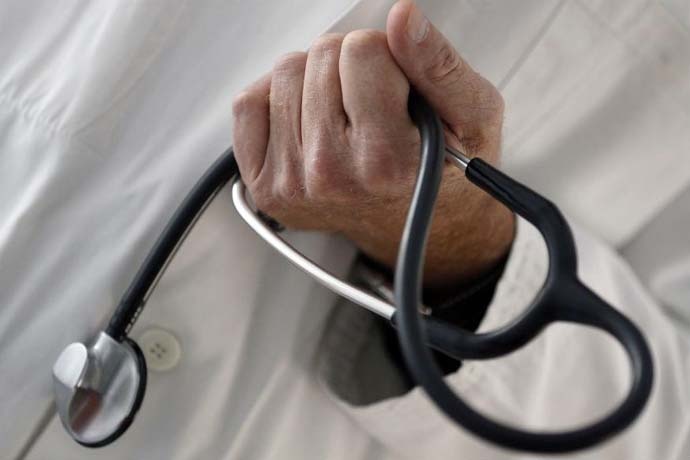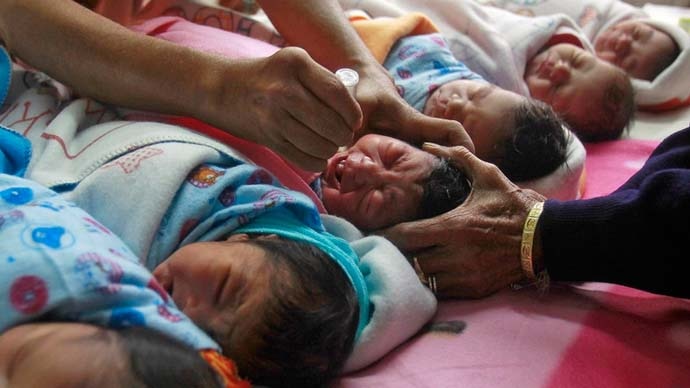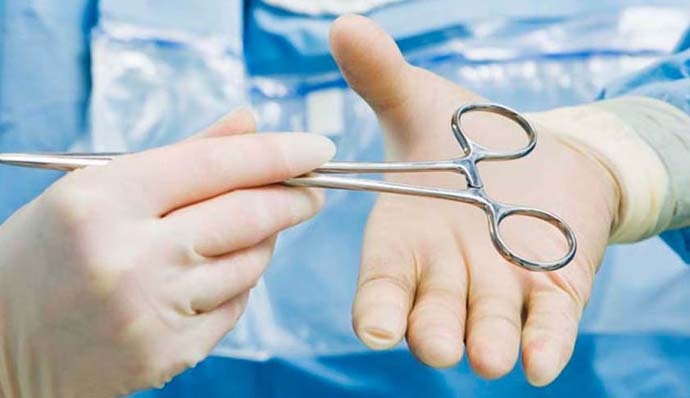Save the saviour: Blaming striking doctors for protesting violence is despicable

A CCTV grab that surfaced on social media, on March 12, showed a group of more than 30 people thrashing a doctor in the hospital ward at Government Medical College, Dhule.
He was beaten up because he referred the relatives of a patient who had suffered a massive head injury to a neurosurgeon at a tertiary-level hospital.
The assaulted doctor's brain scan shows a fracture in the left eye orbit that could lead to vision loss.
Similar cases of assault on resident doctors were reported from Civil Hospital, Nashik and Sion Hospital, Mumbai — all within the span of one week.
The issues over which the incidents took place were either systemic or inevitable — and not remotely the fault of the hapless doctors.
 |
| Save the saviour. Photo: PTI |
I am propelled to write this piece here not just because it spells a harsh future for the medical profession in India, but also because its saddens me that my best friend, who is one of the most formidable women I've met, resigned from her residency at JJ Hospital.
She has always been a proponent of hope and beacon of inspiration.
Her tenacity has made her endure the rigorous academic cycle, competition as well as the deplorable conditions of sleeping in wards, skipping meals and several hours of being on call — all this she has done with unparalleled zeal.
I have sensed her trauma as she saw babies die every odd day, her elation as she held newborns she had helped bring into this world, in neonatal ward.
Over the years, she has compromised on many things — festivals, marriages, anniversaries, what have you.
I distinctly remember joking that she should have opted for an MHA (Masters of Health Administration) instead of MD (paediatrician) for better financial prospects, to which she had a dignified reply: “I work for I care."
Today, for the first time, I see her question her decision to opt for medicine — not because she's vulnerable or weak, but because she isn’t allowed to demand her right to safety.
“If you (doctors) do not want to work, then resign. You are not factory workers who resort to such protests. Shame on you. How can doctors behave in such a manner?” asked the division bench of the Bombay High Court on Tuesday, slamming the “no-show agitation” launched by resident doctors across Maharashtra.
With due respect, the verdict and comparison are imperious and left us desolate.
A resident isn't a worker for no industrial worker would engage in jobs where you labour for 15 to 37 hours.
 |
| At district hospitals, a resident doctor is not only the first point of contact with patients, but also the one handling the maximum workload. Photo: PTI |
It's a complete failure of the judicial machinery as it chose to indict a profession on the whole, when it is incumbent upon it to offer real-time measures for the crisis.
Rebuke doctors for the "mass leave" if you must, but ensure the grievances are heard, that security is provided and that residents are not overworked and underpaid.
Doctors need this confidence and compassion if they are to deal with grave cases, not live in the constant fear of being lynched by a mob.
Indian media has played a major role in demonising doctors with the purpose of peddling news.
Journalism has become increasingly combative and, as a result, indicting doctors sans proof has been normalised.
This brand of journalism sells a negative image of the medical community.
Since it might be callous to pin the blame on the patient or the attendants, Indian media outlets find it convenient to scapegoat the physician, causing the public to start a witch hunt, no less.
Such fear mongering has sown seeds of deep suspicion in the minds of the people.
For instance, among major media outlets, there has been a predilection to suggest that due to the striking resident doctors, emergency cases are being compromised, which is factually wrong as the only reason senior doctors have not joined the protests is to ensure emergencies are covered.
Anybody who cares to scrutinise the multitude of episodes of violence would establish that the greatest proportion of such assaults happen with resident doctors, or doctors who are still in the process of honing their skills.
This is perfectly understandable because in big tertiary centres such as district hospitals, a resident doctor is not only the first point of contact with patients, but also the one handling the maximum workload.
They put in hours, even days at a time and, in the process, presumed to be tolerant and compliant enough to earn a satisfactory evaluation from their seniors.
Shouldn't the resident doctor, based on the precedent put forward by the judicial verdict, legally decline to work more than what human rights law allows the world over?
A study by the Indian Medical Association (IMA) has revealed that more than 75 per cent doctors have experienced violence at work.
The Maharashtra government, in 2010, yielded to the long-standing demands of the medical community and passed the Maharashtra Medicare Service Persons and Medicare Service Institutions (Prevention of Violence and Damage or Loss to Property) Act, 2009.
According to the Act, violence against doctors, medical staff and medical establishments is a non-bailable offence, attracting imprisonment of up to three years and a fine of up to Rs 50,000.
Also, the offender would have to pay twice the amount of damage or loss caused to property as compensation.
Unfortunately, with no awareness created about around it, the Act seems to be followed only on paper.
The police is largely unaware of its existence. The handling of such assault is so depraved that despite 53 doctors suffering attacks in the past two years, not a single conviction was made.
Disowning responsibility amounts to nothing short of laxity of duty.
Perceiving the ever-sensitive atmosphere in any healthcare vicinity, the action plan to foil episodes of violence should have been conceived long ago.
Yet, every new incident brings little in the form of action other than verbal condemnation, futile protests and candlelight marches.
 |
| Faith in the doctor–patient relationship has taken a beating over the last few decades. Photo: Reuters |
Every time such horrific assaults take place, we see the political powers turn into mute spectators, waiting for flames to subside.
What keeps us from addressing the issue? Have we reached the rock bottom of appeasement politics?
A multi-faceted problem
The origin of the issue is multi-faceted.
Over the past two decades, the Indian subcontinent has experienced a fiscal boom — so much so that the social fabric of the region, as laid down by Gandhi, has slowly become capitalistic.
With the rise of commercial hospitals, the mentality of parents to let their children choose medicine has changed from a charitable to a lucrative one.
This change has drastically influenced people's perception of doctors.
Earlier even when there used to be one medical officer for an entire village or a small district, people's trust in the doctor remained high.
The doctor was regarded as part of the local community and integral to the health and well-being of the social unit.
Faith in the doctor–patient relationship has taken a beating over the last few decades.
In earlier times, people went into the medical profession for the predominant vision of serving the ailing mankind, and thus were viewed as saints.
Over time, with the privatisation of healthcare, some doctors were blamed of being driven by greed and of embracing unethical practices.
The ravenous media rapidly jumped to conclusions and published sensational stories of organ theft, medical negligence and malpractice.
Reports about unnecessary tests and needless invasive procedures have caused patients' distrust to grow.
Government hospitals in India follow the welfare model, as the majority of the population is poor and does not have health insurance.
Such hospitals, offering subsidised medical care are flooded with patients and their attendants.
 |
| In addition to jeopardising the safety of medical personnel, violence threatens patient safety and hampers their recovery to health. Photo: Reuters |
The average medical officer posted in the outpatient department sees close to 350 patients a day.
It is reasonable to conjecture that the quality of healthcare is compromised while attending to such a huge number of patients in a short period.
This may lend the impression of neglect to the patient and leave him/her only partially satisfied.
After waiting in long queues for hours, some patients' attendants find themselves at the brink of an emotional cliff.
Ineffective communication or delay in attending to a patient can easily drive them over the edge.
Since most patients lack health insurance, at times, the diagnosis comes as a financial disaster and shocks them into emotional turmoil.
This results in the displacement of anger toward the physician.
The expenditure on healthcare in last fiscal (2015-2016) by the Centre and state governments was merely 1.3 per cent of the GDP.
Most government hospitals in India lack adequate security personnel. During the late hours, it is often the medical officer who plays the role of the doctor, as well as that of the security guard.
There is no established protocol for tackling violence or shooting incidents.
 |
| Laws against doctor assault should be prominently displayed on the walls of the hospital. Photo: Independent Blog |
Most of the police force is plagued by corruption and prone to bribery. Hence, relying on the police for safety is more often than not useless.
The public struggles with a lack of faith in the judicial system and feels it is only the rich who obtain justice.
Thus, in instances of patient deaths, people believe in exacting immediate revenge, seeking their "pound of flesh" using physical means rather than filing a case in courts.
The cure
What can be done? Though the scenario seems gloomy, tackling the problem requires residents' participation.
Doctors should work with the government in creating an effective strategy to prevent hospital violence.
Security personnel should be posted at the entrance of every hospital and should not let anyone through without checking for identification.
Weapons should be confiscated before allowing passage to anyone.
All attendants must register at the front desk and be given a visitor badge to be worn at all times.
No more than two attendants should be allowed with the patient.
Laws against doctor assault should be prominently displayed on the walls of the hospital.
To ensure doctor safety, every hospital should create an emergency protocol and an evacuation plan in case of a major act of violence.
The above measures are in conjunction with the demands listed by Maharashtra Association of Resident Doctors (MARD) and Indian Medical Association (Maharashtra unit).
Violence in any form and, in any setting, is despicable.
However, acts of violence in a hospital are the most extreme and should be dealt with an iron hand. Hospitals are sanctums of healing and recuperation.
In addition to jeopardising the safety of medical personnel, violence threatens patient safety and hampers their recovery to health.
For the better of the society, doctors too — rather than giving the cold shoulder to the other aggrieved parties — should work in tandem with the government as well as the public, to tide over this crisis.
PS: I am sorry if I’ve hurt individual sentiments, I only want the issue to be resolved as soon as possible and for the likes of my friend to resume work that drives their passion.

